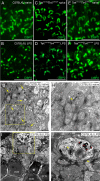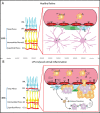Endothelial Toll-like receptor 4 is required for microglia activation in the murine retina after systemic lipopolysaccharide exposure
- PMID: 36739425
- PMCID: PMC9899393
- DOI: 10.1186/s12974-023-02712-1
Endothelial Toll-like receptor 4 is required for microglia activation in the murine retina after systemic lipopolysaccharide exposure
Abstract
Background: Clustering of microglia around the vasculature has been reported in the retina and the brain after systemic administration of lipopolysaccharides (LPS) in mice. LPS acts via activation of Toll-like receptor 4 (TRL4), which is expressed in several cell types including microglia, monocytes and vascular endothelial cells. The purpose of this study was to investigate the effect of systemic LPS in the pigmented mouse retina and the involvement of endothelial TLR4 in LPS-induced retinal microglia activation.
Methods: C57BL/6J, conditional knockout mice that lack Tlr4 expression selectively on endothelial cells (TekCre-posTlr4loxP/loxP) and TekCre-negTlr4loxP/loxP mice were used. The mice were injected with 1 mg/kg LPS via the tail vein once per day for a total of 4 days. Prior to initiation of LPS injections and approximately 5 h after the last injection, in vivo imaging using fluorescein angiography and spectral-domain optical coherence tomography was performed. Immunohistochemistry, flow cytometry, electroretinography and transmission electron microscopy were utilized to investigate the role of endothelial TLR4 in LPS-induced microglia activation and retinal function.
Results: Activation of microglia, infiltration of monocyte-derived macrophages, impaired ribbon synapse organization and retinal dysfunction were observed after the LPS exposure in C57BL/6J and TekCre-negTlr4loxP/loxP mice. None of these effects were observed in the retinas of conditional Tlr4 knockout mice after the LPS challenge.
Conclusions: The findings of the present study suggest that systemic LPS exposure can have detrimental effects in the healthy retina and that TLR4 expressed on endothelial cells is essential for retinal microglia activation and retinal dysfunction upon systemic LPS challenge. This important finding provides new insights into the role of microglia-endothelial cell interaction in inflammatory retinal disease.
Keywords: Endothelial cells; Lipopolysaccharide; Microglia; Monocyte-derived macrophages; Retina; Toll-like receptor 4.
© 2023. The Author(s).
Conflict of interest statement
I.T., Boehringer Ingelheim (F); B.L.S, none; P.E., Novartis Pharma Schweiz (C); M.S.Z., Bayer (F, C), Heidelberg Engineering (S), Novartis (C, I), Boehringer Ingelheim (F); P.M.B., Boehringer Ingelheim (E); D. K., Boehringer Ingelheim (F).
Figures






Similar articles
-
Retinal cell type-specific prevention of ischemia-induced damages by LPS-TLR4 signaling through microglia.J Neurochem. 2013 Jul;126(2):243-60. doi: 10.1111/jnc.12262. Epub 2013 May 13. J Neurochem. 2013. PMID: 23574143
-
Colony-stimulating factor 1 receptor inhibition prevents disruption of the blood-retina barrier during chronic inflammation.J Neuroinflammation. 2018 Dec 12;15(1):340. doi: 10.1186/s12974-018-1373-4. J Neuroinflammation. 2018. PMID: 30541565 Free PMC article.
-
High-fat diet induces toll-like receptor 4-dependent macrophage/microglial cell activation and retinal impairment.Invest Ophthalmol Vis Sci. 2015 May;56(5):3041-50. doi: 10.1167/iovs.15-16504. Invest Ophthalmol Vis Sci. 2015. PMID: 26024088
-
Microglial response to LPS increases in wild-type mice during aging but diminishes in an Alzheimer's mouse model: Implication of TLR4 signaling in disease progression.Biochem Biophys Res Commun. 2016 Oct 14;479(2):331-337. doi: 10.1016/j.bbrc.2016.09.073. Epub 2016 Sep 15. Biochem Biophys Res Commun. 2016. PMID: 27641666 Free PMC article.
-
Prothymosin α Plays Role as a Brain Guardian through Ecto-F1 ATPase-P2Y12 Complex and TLR4/MD2.Cells. 2023 Feb 2;12(3):496. doi: 10.3390/cells12030496. Cells. 2023. PMID: 36766838 Free PMC article. Review.
Cited by
-
Assessing the role of T cells in response to retinal injury to uncover new therapeutic targets for the treatment of retinal degeneration.J Neuroinflammation. 2023 Sep 9;20(1):206. doi: 10.1186/s12974-023-02867-x. J Neuroinflammation. 2023. PMID: 37689689 Free PMC article.
-
The gut-eye axis: from brain neurodegenerative diseases to age-related macular degeneration.Neural Regen Res. 2025 Oct 1;20(10):2741-2757. doi: 10.4103/NRR.NRR-D-24-00531. Epub 2024 Oct 22. Neural Regen Res. 2025. PMID: 39435619 Free PMC article.
-
Brain-derived neurotrophic factor from microglia regulates neuronal development in the medial prefrontal cortex and its associated social behavior.Mol Psychiatry. 2024 May;29(5):1338-1349. doi: 10.1038/s41380-024-02413-y. Epub 2024 Jan 19. Mol Psychiatry. 2024. PMID: 38243072 Free PMC article.
-
TLR4 deficiency does not alter glaucomatous progression in a mouse model of chronic glaucoma.Sci Rep. 2025 May 15;15(1):16852. doi: 10.1038/s41598-025-00638-7. Sci Rep. 2025. PMID: 40374644 Free PMC article.
-
Novel Small Molecules with Anti-Inflammatory and Anti-Angiogenic Activity in a Mouse Model of Oxygen-Induced Retinopathy.Cells. 2024 Aug 17;13(16):1371. doi: 10.3390/cells13161371. Cells. 2024. PMID: 39195259 Free PMC article.
References
-
- Caso JR, Pradillo JM, Hurtado O, Lorenzo P, Moro MA, Lizasoain I. Toll-like receptor 4 is involved in brain damage and inflammation after experimental stroke. Circulation. 2007;115(12):1599–1608. - PubMed
MeSH terms
Substances
LinkOut - more resources
Full Text Sources
Molecular Biology Databases
Miscellaneous

